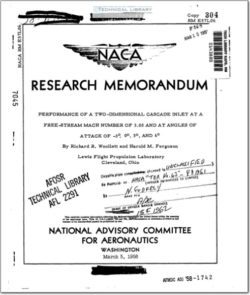naca-rm-e57l06

- Version
- 156 Downloads
- 1.04 MB File Size
- 1 File Count
- April 29, 2016 Create Date
- April 29, 2016 Last Updated
National Advisory Committee for Aeronautics, Research Memorandum - Performance of a Two-Dimensional Cascade Inlet at a Free-Stream Mach Number of 3.05 and at Angles of Attack of -3°, 0°, 3°, and 6°

A double—ramp cascade inlet was investigated.at a Mach number of
3.05 in order to ascertain the penalties associated with decreasing the
length of inlets by means of cascades. Total-pressure recovery and profile
distortion of the cascade inlet were compared with a similar single—
passage inlet that captured the same mass flow. The critical total-
pressure recoveries of the cascade and single-passage inlet were 0.56 and
0.59, respectively, although the peak recoveries were 0.56 and 0.62, re-
spectively. This 0.05 to 0.06 loss in recovery was accompanied by an
improvement in profile distortion. Ebwever, a rather severe pressure and
mass-flow discontinuity exists when the cascade inlet goes into subcritical
operation. Pressure recovery decreased.from the previously mentioned
value to 0.58, while the mass flow dropped from 1 to 0.64. In addition,
positive angle-of-attack performance was extremely penalized; the total-
pressure recovery dropped approximately 0.28 percentage points for a
positive angle of attack of 6°.
The effect of maintainance of separate flow passages throughout the
inlet had no discernible effect upon the critical and supercritical inlet
performance.
The ducting between the entrance of a supersonic inlet and the com-
pressor face can assume an undesirable length in present-day and future
high—speed aircraft, primarily'because of the slow diffusion rates re-
quired for high—performance subsonic diffusers. The length can be de-
creased by increasing the rate of subsonic diffusion and accepting the
resulting total-pressure losses. Another method that can be used to
shorten the inlet is the cascade principle. If a group of small inlets
are arranged in such a manner that the "starting" condition of any one is
not altered by the grouping, a considerable reduction in diffuser length
can be realized. In addition to a reduction in diffuser length, there are
several other advantages associated with the cascade design.
| File | Action |
|---|---|
| naca-rm-e57l06 Performance of a Two-Dimensional Cascade Inlet at a Free-Stream Mach Number of 3.05 and at Angles of Attack of -3°, 0°, 3°, and 6°.pdf | Download |

Comment On This Post